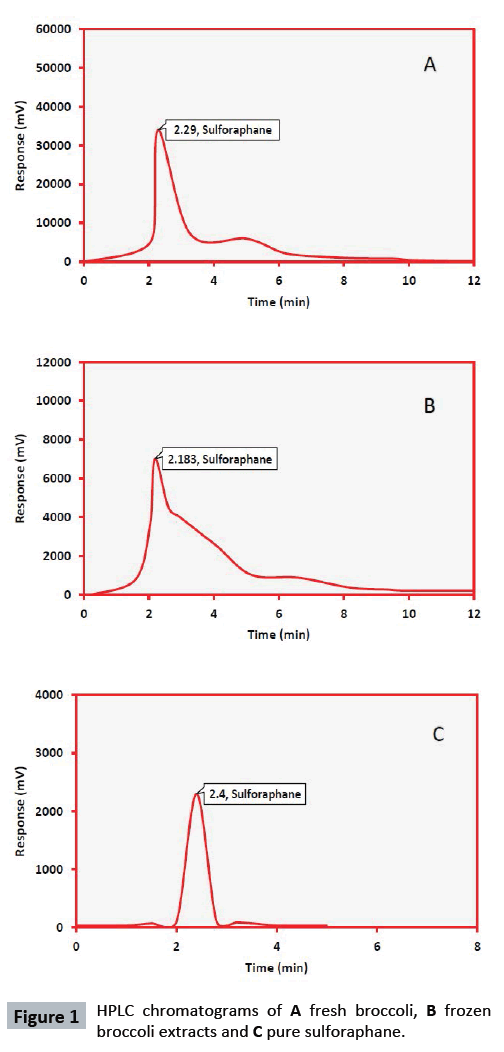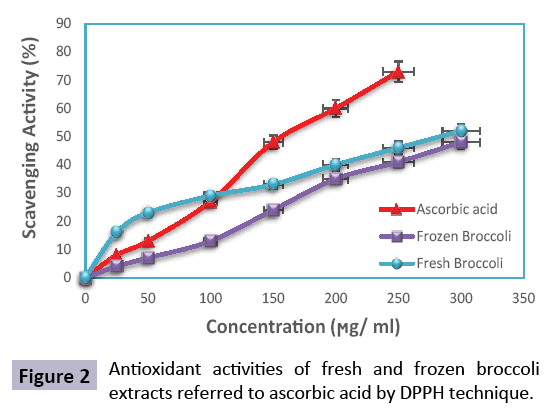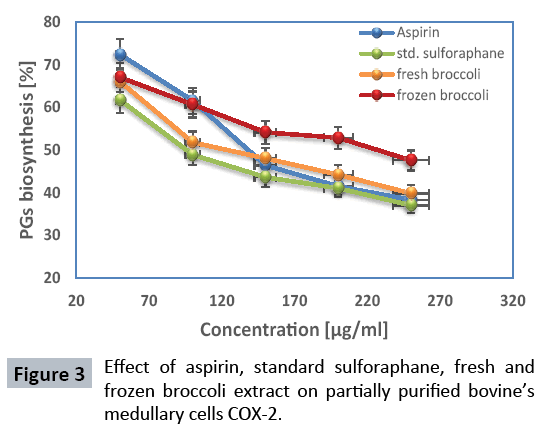Keywords
Freezing; Antioxidant; Anti-inflammatory; Polyphenols; B oleracea; Sulforaphan
Introduction
A wide variety of chemical compounds synthesized in plants are used to perform important biological functions and to defend against attack from predators like polyphenols and isothicyanates. Chemical compounds in plants mediate their effect on the human body through processes identical to those already well understood for the chemical compounds in conventional drugs; thus, herbal medicines do not differ greatly from conventional drugs in terms of how they work [1,2]. Brassicaceae species are one of the most important European crops as it includes nutritionally important human and animal foodstuffs such as Brassica oleracea and Brassica rapa varieties [3]. Upon mechanical damage, infection or pest attack, cellular breakdown and/or chewing exposes the stored glucosinolates to endogenous degradative enzymes called myrosinases [4]. Products derived from glucosinolate breakdown, sulforaphane (1-isothiocyanato-4-(methylsulfinyl)-butane), exert a variety of biological activities in plants, animals, and humans, which can be processed into an anti-cancer, antimicrobial and anti-inflammatory activities [5]. On the other hand, Polyphenols are secondary metabolites involved in defense of plants against pathogens and ultraviolet radiation [6]. Therefore, the intake of these compounds may result in reduction of the risk to develop various degenerative diseases triggered by oxidative stress [7]. Besides, there is scientific evidence that support the role of polyphenols as preventive of diabetes, ulcer, osteoporosis and cancer [8,9]. The indirect healthy effects of polyphenols that they are metabolized through the same route as some xenobiotics or endogenous hormones [6]. Technological processes, such as freezing affect bio-active content of cruciferous vegetables [10,11]. Freezing is one of the most popular and effective methods for food preservation, allowing to keep the nutritional and the sensorial properties of the raw materials for extensive periods of time. However, before freezing, foodstuffs are usually subjected to pretreatments such as blanching, which affect the food properties in a major or minor way. Action enzymes have adverse effects on the quality of the fruits and vegetables in the process of freezing, changing their characteristics, apart from color, nutritional value, vitamins and protein substances degrading and causing volatilization of flavors [12]. In view of the above, the main object of this study is to evaluate the content of sulforaphane and polyphenols and to optimize the effect of freezing on chemical constituents and healthy benefits of Brassica oleracea.
Materials and Methods
Chemicals and biochemicals
Arachidonic acid and sulforaphane were purchased from Cayman chemical Co. Michigan, USA. N,N,N',N'-tetramethyl-pphenylenediamine (TMPD) and Tween 40 were purchased from Acros organics Co. New Jersey, USA. Folin-Cicalteu solution, Hematin, DEAE-sepharose, ethanol absolute, acetonitrile HPLC grade, Tannic acid and methanol absolute were purchased from Sigma Aldrich chemicals Co. USA, Methylene chloride and anhydrous sodium sulfate of high grade were purchased from DPH chemicals co. Germany.
Plant materials and extracts preparation
Fresh broccoli was purchased from local market of Egypt that was selected randomly and identified by Botany Department, Faculty of Science, Tanta University. Then, they were drained and washed three times with distilled water and half of the amount was kept in -20°C for 48 hours.250 g fresh and 190 g frozen mature broccoli were homogenized vigorously using Kenwood kitchen blender, Germany. The homogenized plants were extracted three times with equal volumes of methylen chloride with stirring under reflux at room temperature for 12 hours. Then, the methylen chloride layers were filtered through sterilized cloth sheath then kept over anhydrous sodium sulfate which then combined and dried at 32°C under vacuum in a rotary evaporator. The residue was re-dissolved in 50 mL of 5% acetonitrile in water (v/v). After that, the aqueous phase was extracted three times with equal volumes of excess methylen chloride that was dried over anhydrous sodium sulfate, and filtered through filter paper (Whatman No.1). The filtrate was dried at 33°C under vacuum in a rotary evaporator. The dry extracts of fresh and frozen mature head were dissolved in 5 mL of methanol and filtered through 0.45 μM membrane filter and then was stored at -20°C [13].
Phytochemicals analysis
Determination of total polyphenolic content: Total polyphenolic content (TPC) of extracts was determined using Folin–Ciocalteau’s phenol reagent [14]. 0.5 mL of the polyphenolic extracts were pipetted out into test tubes and the volumes were completed to 3 mL with water. Then, 0.5 mL of Folin–Ciocalteau reagent was added to each tube and incubated for 3 min. 2 mL of 20% Na2CO3 solution was added to each tube. Solutions were mixed and incubated at room temperature for one hour and its absorbance was measured at 650 nm against a reagent blank. Results were expressed as mg tannic acid equivalents per g of fresh weight (mg TAE/g FW) of extract through the calibration curve of tannic acid (2-10 μg/mL).
Determination of sulforaphane concentration by HPLC: The different methanol plant extracts and gradient pure sulforaphane concentrations in acetonitrile were injected into HPLC of Micro analytical unit, Faculty of Science, Cairo University, according the method of Azizi et al. In this study, a reversed-phase C18 analytical column (250 x 4.6 mm, 5 μM) in an YL 9100 HPLC-YL, Japan, was used in the analysis of sulforaphane. For analysis, isocratic elution was carried out with acetonitrile/water 35/65 (v/v) at a column temperature of 30°C. 50 μL portions were injected manually with a flow rate 1 mL/min. Sulforaphane was detected by UV absorbance detector at 254 nm [13].
Antioxidant capacity analysis
Total antioxidant activity was estimated according the method described by refs. [15,16] of 2, 2-diphenyl-1-picrylhydrazyl (DPPH)free radical scavenging capacity. 0.1 mL of sample extract was added to 3.9 ml of 0.1 mM DPPH solution. The mixture was shaken vigorously and allowed to stand in the dark at room temperature for 1 hour. The decrease in absorbance of the solution was monitored at 515 nm spectrophotometrically after 1 hour of reaction. Blank consisted of 0.1 ml methanol and 3.9 mL of DPPH solution. Ascorbic acid (50-250 μg/mL) antioxidant activity was carried out as a reference.
Anti-inflammatory activity determination
Cyclooxygenase purification: Partially purified cyclooxygenase from normal bovine kidney steps were carried out by the method of Hemler and Lands, 1976. 20% Crude homogenate was prepared in Tris-HCl buffer (0.1 M, pH8.0); ammonium sulphate precipitation was performed gradually by 25% then 54% saturation; dialysis was performed to remove the excess of ammonium sulphate bound to protein and DEAE-sepharose column chromatography [17].
In vitro anti-inflammatory assay: The enzyme activity was assayed calorimetrically by monitoring the appearance of oxidized-TMPD at 600 nm [18,19]. The assay mixture contained Tris-HCl buffer (0.1 M, pH 8), Hematin (60 μM), EDTA (3 μM), enzyme (10% of total volume) and test compounds (50-250 μg/mL) of Aspirin (as anti-inflammatory reference) in DMSO, sulforaphane (as an inhibitor std.) in acetonitrile and extracts concentrations were prepared in ethanol absolute. The mixture was incubated for 10 minutes at 25°C and then, the reaction was initiated by the addition of arachidonic acid (200 μM) and TMPD (3.3 mM) in a total volume of 1 ml. The blank was assembled by subjecting inactive enzyme (boiled fractions) instead of active one.
Results and Discussion
Polyphenolic content
The observed polyphenols concentrations equivalent to tannic acid that observed according calibration curve obtain by DPPH scavenging percentage, showed that the frozen broccoli caps was less 35.25% than raw fresh one, as the concentrations are 0.18 and 0.278 mg TAE g-1 FW, respectively (Table 1), which is come with the results of studying the effect of processing on polyphenols content in broccoli tissues, as polyphenols concentration decreased by freezing of fresh broccoli to 37% [20]. These findings are considerably lower than those reported by Mahn et al who indicated loss in 48.7% of polyphenols by freeze-drying [21]. Other studies observed the negative effect of freeze-storing of vegetables by constituents' analysis [22- 25]. However, a comparison of the obtained results with those quoted above is difficult since in other study frozen products were prepared for consumption after each storage period while the above authors analyzed frozen samples only after defrosting that showed 34.4% decreasing in polyphenols [22]. Volden et al. reported the decrease in polyphenols by freezing in 10-21% [26].
Table 1 Polyphenols and sulforaphane contents of fresh and frozen broccoli.
| Bio-active compounds |
Raw broccoli |
Frozen broccolia |
Polyphenols
(mg TAEb/g FWc) |
0.278 |
0.18 |
Sulforaphane
(ûg/g FW) |
110.9 |
71.16 |
aBroccoli freezing at -20°C for 48 hours.
bTannic acid equivalent.
cFresh weight.
Sulforaphane content
The significant values of sulforaphane concentrations were found the highest in raw fresh plant (Figure 1). Frozen broccoli's sulforaphane decreased into 71.16 from 110.9 Mg/g FW of raw fresh one (Table 1). These 35.8% decreasing was relevant to inhibition of hydrolysis process of sulforaphane precursor, glucoraphanin, by myrosinase enzyme. As broccoli considered the richest source of glucoraphanin (81.8% of total glucosinolates), a study on the effect of freezing showed decreasing in concentration by 22.3% after 48 H at -22°C that may be related to freeze-thaw fracture of plant cells by ice crystals [27]. The fact that losses of glucosinolates resulting from prolonged freezing of vegetables has been come after broccoli loss 27% of glucoraphanin after freezing at 4-8°C for 7 days and 53% after storing at -85°C [28]. This state was confirmed when Volden et al. noted that freezing decreases glucosinolates content by 30-52% [26].

Figure 1: HPLC chromatograms of A fresh broccoli, B frozen broccoli extracts and C pure sulforaphane.
Antioxidant activity
Broccoli is widely considered to possess high levels of antioxidant activity [29]; however, specific values for antioxidant activity of broccoli vary greatly between studies. In recent study, antioxidant activities from raw (IC50=275 ûg/mL) to frozen broccoli (IC50=295 ûg/mL) extracts were decreased by only 7% (Table 2 and Figure 2). This result confirmed that the antioxidant activity not only relative to polyphenols, but also elevated by other components that might not affected by freezing. By studying antioxidant activity (radical scavenging) of pure sulforaphane, it was found that it didn't possess any activity. Other studies showed that antioxidant capacity of broccoli was significantly reduced in 56.5% by freeze-drying in different ways [21], therefore freeze-drying processing result in further tissue dehydration that loss viability of cell content and activity. Antioxidant activity decreased into 33% after refrigerated storing or either after 12 months [22]. Puupponen-Pimiä et al. observed a pronounced decrease in the DPPH scavenging during the freeze-storage of broccoli [25].
Table 2 IC50 of antioxidant and anti-inflammatory activities of fresh and frozen broccoli.
IC50 value*
(µg/ml) |
Raw broccoli |
Frozen broccoli |
Ascorbic acid |
Sulforaphane |
| Antioxidant |
275 |
295 |
150 |
- |
| Anti-inflammatory |
127 |
226 |
- |
98 |
*IC50: 50% of inhibitory concentration.

Figure 2: Antioxidant activities of fresh and frozen broccoli extracts referred to ascorbic acid by DPPH technique.
Anti-inflammatory activity
Anti-inflammatory activity was detected by the measurement of oxidized N, N, N', TMPD which is a reducing agent. Comparable dose-inhibition curves for aspirin, flufenamate, pure and extracted sulforaphane were obtained (Figure 3). The potency of pure sulforaphane (IC50=98 μg/mL) and extracted sulforaphane from raw fresh and frozen broccoli (IC50=127 and 226 μg/mL, respectively) were higher than those of aspirin and flufenamate (IC50=140 and 198 μg/mL, respectively). All the studies come with that the freezing not only decreases total glucosinolates which sulforaphane precursor, glucoraphanin, represents more than 80% of it, the point that assured the depletion in sulforaphane concentration but also, myrosinase inhibition have a rest in this effect. Thus, in this study, as sulforaphane concentration decreased as anti-inflammatory activity decreased by 43.8% (Table 2).

Figure 3: Effect of aspirin, standard sulforaphane, fresh and frozen broccoli extract on partially purified bovine’s medullary cells COX-2.
Acknowledgement
We acknowledge Tanta University for generous supplying and the Biochemistry unit members for helpful discussions and supporting data.
References
- Williams PG (2006) Health benefits of herbs and spices: the past, the present, the future-Public Health.
- Lai PK, Roy J (2004) Antimicrobial and chemopreventive properties of herbs and spices. Curr Med Chem 11: 1451-1460.
- Fahey JW, Zhang Y, Talalay P (1997) Broccoli sprouts: an exceptionally rich source of inducers of enzymes that protect against chemical carcinogens. Proc Natl Acad Sci 94: 10367-10372.
- Grubb CD, Abel S (2006) Glucosinolate metabolism and its control. Trends Plant Sci 11: 89-100.
- Gabriel D, Roedl D, Gordon LB, Djabali K (2015) Sulforaphane enhances progerin clearance in Hutchinson-Gilford progeria fibroblasts. Aging Cell 14: 78-91.
- Manach C, Scalbert A, Morand C, Remesy C, Jimenez L (2004) Polyphenols: food sources and bioavailability. Am J Clin Nutr 79: 727-747.
- Archivio MD, Filesi C, Benedetto R, Gargiulo R, Giovannini C, et al. (2007) Polyphenols, dietary sources and bioavailability. Ann Ist Super Sanità 43: 348.
- Scalbert A, Manach C, Morand C, Remesy C, Jimenez L (2005) Dietary polyphenols and the prevention of diseases. Crit Rev Food Sci Nutr 45: 287-306.
- Shi J, Nawaz H, Pohorly J, Mittal G, Kakuda Y, et al. (2005) Extraction of polyphenolics from plant material for functional foods-engineering and technology. Food Rev Int 21: 139-166.
- McNaughton SA, Marks GC (2003) Development of a food composition database for the estimation of dietary intakes of glucosinolates, the biologically active constituents of cruciferous vegetables. Br J Nutr 90: 687-697.
- Schone F, Kirchheim U, Schumann W (1994) Glucosinolate degradation by rapeseed myrosinase and effect on rapeseed acceptability by growing pigs. Anim Feed Sci Technol 48: 229-235.
- Lee SK, Kader AA (2000) Preharvest and postharvest factors influencing vitamin C content of horticultural crops. Postharvest Biol Technol 20: 207-220.
- Azizi Naser S, Amiri-Besheli B, Sharifi-Mehr S (2011) The isolation and determination of sulforaphane from broccoli tissues by reverse phase-High Performance Liquid Chromatography. J Chin Chem Soc 58: 906-910.
- Ganesan P, Kumar CS, Bhaskar N (2008) Antioxidant properties of methanol extract and its solvent fractions obtained from selected Indian red seaweeds. Biores Tech 99: 2717-2723.
- Molyneux P (2004) The use of the stable free radical diphenylpicrylhydrazyl (DPPH) for estimating antioxidant activity. Songklanakarin J Sci Technol 26: 211-219.
- Thaipong K, Boonprakob U, Crosby K, Cisneros-Zevallos L, Byrne DH (2006) Comparison of ABTS, DPPH, FRAP, and ORAC assays for estimating antioxidant activity from guava fruit extracts. J Food Comp Anal 19: 669-675.
- Hemler M, Lands WE (1976) Purification of the cyclooxygenase that forms prostaglandins. Demonstration of two forms of iron in the holoenzyme. J Biol Chem 251: 5575-5579.
- Copeland RA, Williams JM, Giannaras J, Nurnberg S, Covington M, et al. (1994) Mechanism of selective inhibition of the inducible isoform of prostaglandin G/H synthase. Proc Natl Acad Sci 91: 11202-11206.
- Burnett BP, Jia Q, Zhao Y, Levy RM (2007) A medicinal extract of Scutellaria baicalensis and Acacia catechu acts as a dual inhibitor of cyclooxygenase and 5-lipoxygenase to reduce inflammation. J med food 10: 442-451.
- Mahn A, Reyes A (2012) An overview of health-promoting compounds of broccoli (Brassica oleracea var. italica) and the effect of processing. Food Sci Technol Int 18: 503-514.
- Mahn A, Zamorano M, Reyes A (2014) Effect of Freeze-Drying Conditions on Antioxidant Compounds of Broccoli. J Food Process Technol 5: 360.
- Gebczynski P, Lisiewska Z (2006) Comparison of the level of selected antioxidative compounds in frozen broccoli produced using traditional and modified methods. Innov Food Sci Emerg Technol 7: 239-245.
- Jaworska G, Kmiecik W (2000) Comparison of the nutritive value of frozen spinach and New Zealand spinach. Pol J Food Nutr Sci 9: 79-84.
- Ninfali P, Bacchiocca M (2003) Polyphenols and antioxidant capacity of vegetables under fresh and frozen conditions. J Agric Food Chem 51: 2222-2226.
- Puupponen-Pimia R, Hakkinen ST, Aarni M, Suortti T, Lampi AM, et al. (2003) Blanching and long-term freezing affect various bioactive compounds of vegetables in different ways. J Sci Food Agr 83: 1389-1402.
- Volden J, Borge GIA, Hansen M, Wicklund T, Bengtsson GB (2009) Processing (blanching, boiling, steaming) effects on the content of glucosinolates and antioxidant-related parameters in cauliflower (Brassica oleracea L. ssp. botrytis). LWT-Food Sci Technol 42: 63-73.
- Cieslik E, Leszczynska T, Filipiak-Florkiewicz A, Sikora E, Pisulewski PM (2007) Effects of some technological processes on glucosinolate contents in cruciferous vegetables. Food Chem 105: 976-981.
- Song L, Thornalley PJ (2007) Effect of storage, processing and cooking on glucosinolate content of Brassica vegetables. Food Chem Toxicol 45: 216-224.
- Roy MK, Juneja LR, Isobe S, Tsushida T (2009) Steam processed broccoli (Brassica oleracea) has higher antioxidant activity in chemical and cellular assay systems. Food Chem 114: 263-269.




